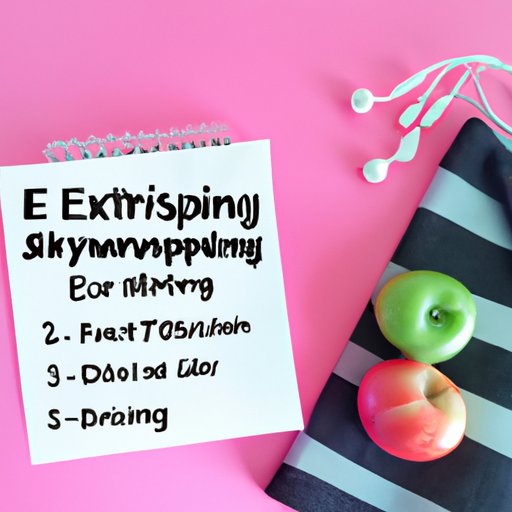Introduction
When it comes to exercise, timing is everything. But what about eating? How long should you wait before hitting the gym after a meal? Many people struggle with this common problem, unsure of the best way to optimize their workouts while still fueling their bodies properly. In this article, we will explore the science behind how long to wait before exercising after eating, how different food types affect exercise performance, and tips on how to maximize your workouts by timing your meals and exercise for maximum benefit.
Breaking Down the Digestive Process: Understanding How Long to Wait Before Exercising
To understand how long to wait before exercising after eating, it’s important to first understand the digestive process. After you eat, your body breaks down food into smaller particles to be absorbed into the bloodstream. This process takes time, and the larger the meal, the longer it takes for the food to be fully digested.
When you exercise, blood flow is redirected away from the digestive system and towards the muscles being worked. This can cause discomfort or even nausea if you exercise too soon after eating. It’s generally recommended to wait at least 1-2 hours after eating before engaging in moderate to intense exercise.
Is it Better to Exercise Before or After Meals? The Science Behind Optimal Timing
While waiting a couple of hours after eating is generally recommended, the optimal timing for exercise depends on the type of exercise you plan to engage in. For low-intensity exercise, such as walking, it’s fine to exercise after a meal. However, for high-intensity exercise, such as weight lifting or running, it’s better to exercise before meals or wait at least 2-3 hours after a meal.
Different food types can also affect exercise performance. High-carbohydrate meals can provide extra energy for intense exercise, while high-fat meals can slow down digestion and cause discomfort during exercise. Protein, on the other hand, is important for muscle repair and growth, making it an important nutrient for post-workout recovery.
Several studies have also examined the optimal timing for meals and exercise. One study found that exercising before breakfast may help with weight loss, while another found that eating a high-carbohydrate meal 2-3 hours before exercise improved endurance. Ultimately, it’s important to experiment with different timings and food types to find what works best for your individual needs.
Maximizing Your Workouts: Tips on When to Eat and Exercise
To maximize your workouts, it’s important to time your meals and exercise accordingly. Here are some tips to consider:
Tips on when to eat before exercising
– For low-intensity exercise, it’s fine to eat a small meal or snack before exercising.
– For high-intensity exercise, it’s better to eat a high-carbohydrate meal 2-3 hours before exercising or a small snack 30-60 minutes prior.
– For evening workouts, it’s important to fuel the body throughout the day to avoid fatigue during exercise.
Tips on how much to eat before exercising
– For low-intensity exercise, a small snack such as a piece of fruit or handful of nuts is sufficient.
– For high-intensity exercise, a meal containing carbohydrates, proteins, and healthy fats is recommended.
Tips on when to exercise after eating
– Wait at least 1-2 hours after eating a small meal before engaging in moderate to intense exercise.
– Wait at least 2-3 hours after eating a large meal before engaging in high-intensity exercise.
Importance of hydration and glycogen stores
– Staying hydrated is essential for exercise performance and recovery.
– Consuming carbohydrates before exercise can help fuel the body and maintain glycogen stores, which are essential for endurance exercise.

Eating to Fuel Your Workout: How Long to Wait Before Hitting the Gym
Eating before exercise is important for fueling the body and optimizing workout performance. However, the type and timing of the meal vary depending on the individual’s goals and workout intensity. Here are some recommendations on how long to wait before exercising after eating different meal types:
– Small snack: Wait at least 30-60 minutes
– Small meal: Wait at least 1-2 hours
– Large meal: Wait at least 2-3 hours
If you don’t have time to eat a full meal before exercising, try consuming a small snack such as a banana, protein bar, or smoothie. For those who prefer to exercise on an empty stomach, it’s important to pay attention to the body’s hunger cues and consume adequate nutrients throughout the day.
Common Myths about Exercising After Eating and the Truth Behind Them
There are several common myths about exercising after eating that can lead to confusion and misinformation. Let’s take a look at some of the most common myths and the truth behind them:
Myth: Exercising after eating will cause cramps and indigestion.
– While it’s true that exercising too soon after eating can cause discomfort, waiting at least 1-2 hours after a small meal or 2-3 hours after a large meal can prevent this.
Myth: You should always exercise on an empty stomach for optimal fat burning.
– While exercising on an empty stomach may increase fat burning during exercise, it can also cause fatigue and decreased performance. Eating a high-carbohydrate meal 2-3 hours before intense exercise can provide extra energy and improve endurance.
Myth: You shouldn’t eat after exercise if you want to lose weight.
– Eating after exercise is important for muscle recovery and glycogen replenishment. Consuming a meal containing protein and carbohydrates within 30 minutes of exercise can enhance muscle repair and growth.
Finding the Sweet Spot: The Ideal Time Gap between Eating and Exercising
The ideal time gap between eating and exercising varies from person to person and depends on several factors, including personal schedule, eating habits, exercise intensity, and fitness goals. In general, waiting at least 1-2 hours after a small meal and 2-3 hours after a large meal is recommended for optimal digestion and exercise performance.
It’s also important to listen to the body’s hunger cues and avoid exercising on an empty stomach if it leads to fatigue or decreased performance. By personalizing your diet and exercise habits, you can optimize your workouts and achieve your fitness goals.
Eating for Energy: A Guide to Timing Your Meals and Exercise for Maximum Benefit
Timing meals for energy and exercise performance is essential for maximizing workouts and preventing fatigue. Here are some tips to consider:
Importance of timing meals for energy and exercise performance
– Eating before exercise provides fuel for the body and improves workout performance.
– Timing meals throughout the day can prevent hunger and fatigue during exercise.
Tips on planning meals around exercise schedule
– Plan meals and snacks around your exercise schedule to ensure adequate fuel.
– Consuming carbohydrates before exercise can help maintain glycogen stores and improve endurance.
Explanation of how food choice affects energy levels
– High-carbohydrate meals provide quick energy for intense exercise.
– Protein is important for muscle repair and growth, making it important for post-workout recovery.
Importance of consistency in diet and exercise routine
– Consistency in diet and exercise routine is important for achieving fitness goals.
– Regular exercise and balanced meals can lead to increased energy and better exercise performance over time.
Conclusion
In conclusion, timing meals and exercise is essential for maximizing workouts and achieving fitness goals. By understanding the digestive process and experimenting with different timings and food types, you can optimize your workouts and fuel your body for optimal performance.
